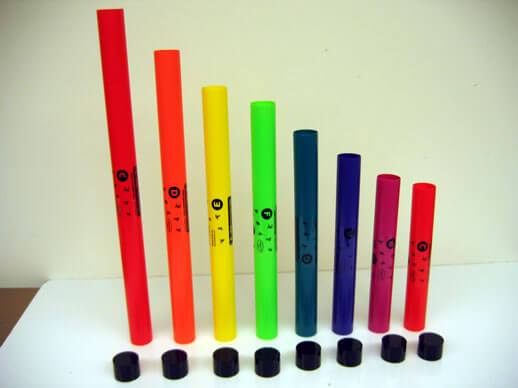[vc_row css_animation=”” row_type=”row” use_row_as_full_screen_section=”no” type=”full_width” angled_section=”no” text_align=”left” background_image_as_pattern=”without_pattern”][vc_column][vc_column_text]There is a lot of science in music. In fact, everything about music, from the way it is produced to the way it sounds, is connected to science. In this activity, we will explore the science of sound through the creation of a very unique musical instrument. So grab your adult assistant and get to wondering!
Here’s What You Need
- 8 feet of 3/4 inch PVC pipe
- A permanent marker
- Ruler
- A saw or PVC cutter
Here’s What You Do
Ask your adult assistant to help you with this part. Using the ruler and PVC cutter (or saw), measure and cut the PVC pipe to the lengths given below:
- White (Note C – 32.77 cm)
- Red (Note D – 29.20 cm)
- Orange (Note E – 26.01 cm)
- Yellow (Note F – 24.55 cm)
- Green (Note G – 21.87 cm)
- Blue (Note A – 19.48 cm)
- Purple (Note B – 17.36 cm)
- Black (Note C – 16.38 cm)
After your adult assistant cuts the pipes, you can use the marker to label each one. Make sure you label it with the first letter(s) of the appropriate color (White, Red, Orange, Yellow, Green, Blue, Purple, BLack). If you have colored markers, you may want to label the pipes with the actual color. Now, you are ready to play!
Playing palm pipes is pretty simple. Grasp one pipe firmly in one hand. Open the other hand in front of you (palm up). Now, strike the open end of the pipe on the palm of your hand (not too hard). Did you hear that? Try a different pipe. Do you notice anything about the sound? If you have seven friends, you can give them each a pipe and, together, you can play the scale. If you want to play some actual music, you can create some of your own or use the music included here:
Ode To Joy: O O Y G G Y O R W W R O O R R O O Y G G Y O R W W R O R W W
Twinkle, Twinkle Little Star: W W G G B B G Y Y O O R R W G G Y Y O O R G G Y Y O O R W W G G B B G Y Y O O R R W
Brahms Lullaby: O O G O O G O G Bl P B B G R O Y R R O Y R Y P B G P Bl W W Bl B Y G O W Y G B O G W W Bl B Y G O W Y G Y O R W
When the Saints Go Marching In: W O Y G W O Y G W O Y G Y W O R O O R W W O G G G Y O Y G Y W R W
The Science Behind The Music
The source of any sound is vibration. When you speak you force air over your vocal cords and cause them to vibrate. You can actually feel the vibration if you place your fingers on your neck (near your voice box) when you are speaking. Your vibrating vocal cords cause the air molecules around them to vibrate. Those molecules cause other air molecules to vibrate and so on and so on. As a result, the sound travels from your vocal cords to the outside world and, ultimately, to someone else’s ears.
Inside a palm pipe, there is a column of air. When you hit the bottom of the pipe, you cause the air molecules to vibrate. That vibration creates the sound you hear. The height of the column of air varies from pipe to pipe. As a result, the vibrating air molecules in each pipe create a slightly different sound.
Wondershop Fast Fact
The fastest harmonica player is Nicky Shane (USA) who played ‘Oh When the Saints Go Marching In’ at a speed of 285 bpm in SRS Studios, Santa Barbara, California, USA, on 8 September 2005.
[/vc_column_text][/vc_column][/vc_row]

















